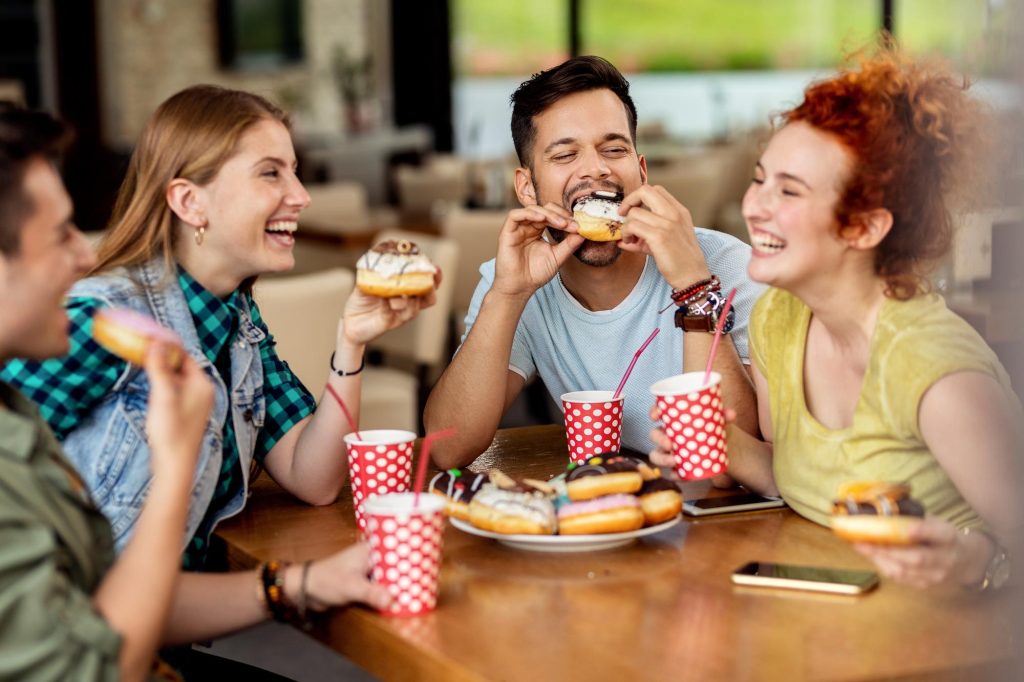
In the age of social media and online platforms, restaurants no longer rely solely on traditional advertising to attract and engage customers. User-generated content (UGC)—such as customer photos, reviews, and social media posts—has become a driving force in restaurant marketing. This authentic content created by diners can shape perceptions, influence purchasing decisions, and increase a restaurant’s reach. In this blog, we will explore the importance of UGC and how it impacts restaurant marketing in a world where customer voices hold as much, if not more, power than traditional ads.
1. The Power of Authenticity
Why Authenticity Matters in Restaurant Marketing
In today’s marketing landscape, consumers are more discerning and can easily detect overly polished or insincere advertising efforts. That’s where user-generated content comes in. UGC is valuable because of its authenticity. When potential customers see real diners sharing their experiences, it feels more genuine compared to professionally staged advertisements. The organic nature of UGC offers a fresh and relatable perspective, making it easier for people to trust and engage with a brand.
One of the key reasons UGC resonates so well is because it taps into peer recommendations. When diners post their photos of meals, share their dining experiences on social media, or leave reviews on platforms like Yelp or Google, it feels like a personal recommendation from a friend rather than a restaurant’s attempt to sell its product. This authenticity is invaluable in building trust.
Building Trust Through Authentic Content
Restaurants that encourage and share UGC create a loyal community of customers who naturally promote the brand. This authenticity helps establish trust—a critical factor in convincing potential customers to give a restaurant a try. When patrons trust a restaurant, they are more likely to recommend it to others and share their positive experiences both online and offline.
How to Leverage UGC for Authenticity:
- Encourage customers to tag the restaurant in their social media posts. This not only builds awareness but also provides potential diners with real reviews and experiences they can trust.
- Feature customer stories or testimonials on your website and social media channels. This humanizes your brand and makes it more relatable to future customers.
2. Social Proof and Credibility
The Role of Social Proof in Restaurant Decisions
Social proof is the psychological phenomenon where people tend to follow the actions of others, especially when making decisions. In the restaurant industry, UGC plays a significant role in reinforcing social proof. When potential diners see a steady flow of positive reviews, photos, and posts from real customers, it validates their decision to choose a particular restaurant.
This form of crowd endorsement is compelling because it suggests that others are already enjoying and recommending the restaurant. The more diners share their experiences, the stronger the restaurant’s social proof becomes, making it easier for future customers to choose the venue with confidence.
Online Reviews as Social Proof
Online reviews have a massive impact on a restaurant’s credibility. According to a BrightLocal survey, 87% of consumers read online reviews for local businesses, and 94% of consumers say that positive reviews increase their likelihood of visiting a business. A restaurant with a wealth of positive reviews and user-generated content is much more attractive to new customers than one with limited or no reviews.
Reviews provide a sense of security for new diners, especially if they are unsure about where to dine. Many people rely on the experiences of others to guide their choices, which makes online reviews a powerful tool for driving new traffic to restaurants.
How to Boost Social Proof:
- Encourage satisfied customers to leave reviews on platforms like Google, Yelp, and TripAdvisor to create a robust repository of social proof.
- Engage with customer posts by liking, sharing, and commenting to show that your restaurant values customer feedback and fosters a positive relationship with patrons.
3. Free and Organic Marketing

UGC as a Cost-Effective Marketing Tool
User-generated content is essentially free advertising for restaurants. Traditional marketing methods, such as print ads or paid promotions, can be expensive and often lack the same authenticity and reach that UGC provides. In contrast, UGC allows restaurants to promote their offerings without a substantial financial investment.
When customers voluntarily post photos of their meals or share their dining experiences on social media, they are promoting the restaurant to their personal networks—often at no cost to the business. This form of word-of-mouth marketing can have a far-reaching effect, as one photo of a beautifully presented dish can be seen by hundreds, or even thousands, of potential diners.
Encouraging Organic Promotion
The reach of UGC is especially powerful when it comes to platforms like Instagram, Facebook, and TikTok. A single post by a diner can inspire many of their followers to visit the restaurant. By encouraging diners to share their experiences, restaurants can harness the power of organic marketing and significantly expand their reach.
This method is particularly effective for smaller or locally-owned restaurants that may not have large marketing budgets. UGC allows them to gain visibility and attract new customers through the power of customer-driven content.
How to Maximize Free Marketing:
- Incentivize diners to share their experiences by offering discounts or promotions in exchange for tagged posts or reviews.
- Create a visually appealing dining space that encourages customers to take photos and share their visit. Instagrammable dishes, unique decor, or fun, interactive elements can make your restaurant a social media hotspot.
4. Visual Appeal and Engagement
The Visual Nature of Food on Social Media
Food is inherently visual, and social media thrives on high-quality, eye-catching images. Platforms like Instagram and Pinterest are perfect for food photography, and customers often love to share their dining experiences—especially if the food looks stunning. Visually appealing content can significantly boost engagement and showcase the restaurant’s offerings in an authentic and enticing way.
Leveraging UGC to Build Your Visual Brand
When customers post photos of their meals, they contribute to the restaurant’s visual brand. This user-generated content can be just as valuable as professionally taken photographs. In many cases, it may even be more effective because it adds a layer of authenticity, demonstrating what the restaurant’s dishes truly look like when served to real customers.
Visual UGC not only helps build the restaurant’s brand but also creates a digital portfolio of the food and experiences offered, giving future diners a chance to browse through real-life examples. Restaurants can encourage even more engagement by resharing these posts on their own social media pages, creating a cycle of visual content that helps attract new diners.
How to Capitalize on Visual UGC:
- Repost customer photos on your restaurant’s Instagram feed or stories to create an ongoing cycle of engagement and to build your visual brand.
- Run photo contests where diners can post their best food photos for a chance to win a prize. This not only drives engagement but also encourages patrons to actively promote your restaurant.
Read More: TikTok Food Challenges for Restaurants and Foodie Influencers
5. Influencing Purchasing Decisions
User-generated content (UGC) plays a crucial role in influencing consumer purchasing decisions, particularly in the restaurant industry. Its impact cannot be overstated, as UGC provides potential customers with a firsthand, unfiltered look at what they can expect when visiting a restaurant. This content, whether it comes in the form of customer photos, reviews, or social media posts, offers an authentic portrayal of the dining experience. UGC can significantly increase a potential customer’s confidence in choosing to dine at a particular restaurant.
According to research by Stackla, 79% of people report that user-generated content significantly impacts their purchasing decisions, while 72% of consumers believe that customer photos and reviews are more trustworthy than branded content. This highlights the fact that UGC is seen as more credible and authentic compared to traditional advertising. Instead of relying on polished marketing campaigns, consumers trust real people who have experienced the service firsthand.
Why UGC is So Influential
A key factor in UGC’s influence is the personal endorsement it provides. When potential customers see a friend or influencer enjoying a meal at a restaurant, it carries more weight than seeing the same meal in a paid advertisement. Seeing real customers engage with a restaurant, whether through a glowing review, a candid photo, or a tagged social media post, builds trust and credibility.
In this context, the endorsement feels genuine and relatable, as it stems from an unbiased source with no direct ties to the restaurant. Customers are more likely to try a new dish or visit a restaurant after seeing positive UGC because they feel like they’re getting a recommendation from a peer rather than being sold a product.
6. Building Community and Loyalty

User-generated content does more than just attract new customers—it helps build a sense of community and loyalty among existing patrons. When customers see their photos, reviews, or social media posts reshared by the restaurant, it makes them feel valued and appreciated. This recognition not only strengthens the relationship between the diner and the restaurant but also creates a sense of belonging. Customers are more likely to return if they feel connected to the establishment on a personal level.
Fostering a Sense of Connection
Social media offers a platform where restaurants can engage directly with their customers, fostering a personal and direct relationship. By featuring customer posts, responding to reviews, and creating campaigns that encourage participation, restaurants can build a loyal community of diners who feel a strong connection to the brand. This level of interaction helps turn one-time visitors into repeat customers, as people appreciate when businesses acknowledge and engage with them.
For example, if a restaurant reshapes a customer’s Instagram photo of their signature dish, it not only shows that the restaurant values the customer’s content but also motivates other patrons to share their experiences in hopes of being featured. This creates a positive feedback loop, where more customers engage with the restaurant in exchange for recognition.
7. SEO Benefits from Reviews and Posts
In addition to enhancing a restaurant’s brand image and customer base, user-generated content provides significant benefits in terms of search engine optimization (SEO). Online reviews, in particular, play a major role in improving a restaurant’s visibility on search engines like Google. A restaurant’s ranking in search results is directly influenced by the quantity and quality of reviews it receives. Google’s algorithm takes these factors into account, meaning that a restaurant with a wealth of positive reviews is more likely to appear at the top of search results.
Why Reviews Matter for SEO
Search engines prioritize content that is relevant, fresh, and trustworthy. Online reviews check all these boxes, as they provide ongoing, user-generated content that reflects real customer experiences. When a restaurant consistently receives reviews, it signals to search engines that the business is active and popular, which can lead to better rankings in local searches.
For example, when potential customers search for “best pizza places near me,” restaurants with high ratings and frequent reviews are more likely to appear at the top of the search results. This improved visibility can lead to increased website traffic and, ultimately, more customers walking through the door.
The Power of Social Media Tags for SEO
User-generated content in the form of social media tags also plays a role in boosting a restaurant’s SEO. When customers tag a restaurant in their posts, it increases the restaurant’s online visibility. These tags often link back to the restaurant’s profile or website, driving traffic and improving its digital footprint.
Every time a customer tags a restaurant in a post, it creates a new entry point for potential customers to discover the business. Over time, these accumulated tags can significantly enhance the restaurant’s online presence, making it easier for potential diners to find it when searching for places to eat.
Conclusion
User-generated content is a powerful tool in restaurant marketing, offering a level of authenticity, reach, and engagement that traditional marketing methods often cannot match. By encouraging diners to share their experiences through photos, reviews, and social media posts, restaurants can leverage UGC to build trust, enhance credibility, and foster a loyal community of customers.
UGC not only influences purchasing decisions by offering potential diners a real look at the restaurant experience but also helps build a strong sense of community and loyalty among existing patrons. Additionally, UGC provides significant SEO benefits, improving search engine rankings and increasing online visibility.
As user-generated content continues to grow in importance, restaurants that embrace and encourage this form of organic marketing will be well-positioned to thrive in today’s digital landscape.
Ready To Get More Diners?